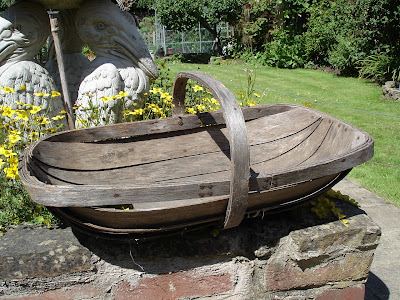
I must confess straight away that I didn't actually grow these giant figs. I have been keeping an eye on these fig trees for a number of years now, they are in a public place near where I live and they are tended every now and then by the council. What I can never figure out, is that nobody apart from me ever picks them. I must assume that the majority of the British (Hillingdon) public do not recognize them for what they are.
I have been keeping an eye on these and noticed recently they were turning brown (ripe). These are most probably the variety
'Brown Turkey' which grows well in our climate. Yesterday I picked about two dozen of these ripe figs, with the promise of dozens more yet to ripen. I've never seen anything like it ! For certain, any British supermarket would reject them.
Which brings me onto a pet subject. UK supermarkets reject any produce from growers which is oversize, undersize, wrong shape, too straight, too curly, wrong colour, blemished..you know the stuff. Esther Rantzen used to show them on 'That's Life'. I was remembering the fun I had as a child picking up the naughty-shaped vegetables.. mis-shapen tomatoes, forked carrots, nobbly potatoes - taking them home and displaying them in the kitchen, perhaps drawing a face on them.
Please can any blog readers photograph their nobbly or naughty veg, and post them on your blog. Let's all have a laugh and remember our childhood!
 I emptied my potato bin today. I planted 2 tubers of maincrop 'Sarpo Mira' back in the Spring. I planted them at the bottom of a black plastic dustbin. Every few weeks I would earth them up until the soil reached the top of the bin. More tubers grow from the stems all the way up to the top. You can only do this with maincrop potatoes and not earlies. Had quite a good crop.
I emptied my potato bin today. I planted 2 tubers of maincrop 'Sarpo Mira' back in the Spring. I planted them at the bottom of a black plastic dustbin. Every few weeks I would earth them up until the soil reached the top of the bin. More tubers grow from the stems all the way up to the top. You can only do this with maincrop potatoes and not earlies. Had quite a good crop. I filled the bin back up to the top, added a few extra ingredients to re-fertilize. I planted a courgette 'Defender' in its place. The first courgette plants are now about 6foot across and in full flow at the moment, they will slow down in a few weeks' time and start to fade. I rekon we will have warm weather right up till October or November, so I have taken a chance on a second crop. I have also just planted out a second sowing of dwarf bean, they will produce beans right up till the first frosts. I have planted a second sowing of greenhouse cucumbers which will be producing fruit when the others are fading away. I planted some perpetual spinach seeds today as well. Don't just think of Spring as the time to sow your seeds. Plan for a mild Autumn too.
I filled the bin back up to the top, added a few extra ingredients to re-fertilize. I planted a courgette 'Defender' in its place. The first courgette plants are now about 6foot across and in full flow at the moment, they will slow down in a few weeks' time and start to fade. I rekon we will have warm weather right up till October or November, so I have taken a chance on a second crop. I have also just planted out a second sowing of dwarf bean, they will produce beans right up till the first frosts. I have planted a second sowing of greenhouse cucumbers which will be producing fruit when the others are fading away. I planted some perpetual spinach seeds today as well. Don't just think of Spring as the time to sow your seeds. Plan for a mild Autumn too. My beetroot 'Detroit' are making superb pickings of golf ball sized beetroots at the moment. The small ones are just bite sized, but my favourite way of eating larger beetroot is to cook them, grate them into a bowl when cool, then spoon horseradish sauce over them. This is a traditional dish in Eastern Europe and Poland. Believe me... these two flavours were born to go with each other. Give it a try, you won't be sorry.
My beetroot 'Detroit' are making superb pickings of golf ball sized beetroots at the moment. The small ones are just bite sized, but my favourite way of eating larger beetroot is to cook them, grate them into a bowl when cool, then spoon horseradish sauce over them. This is a traditional dish in Eastern Europe and Poland. Believe me... these two flavours were born to go with each other. Give it a try, you won't be sorry.























